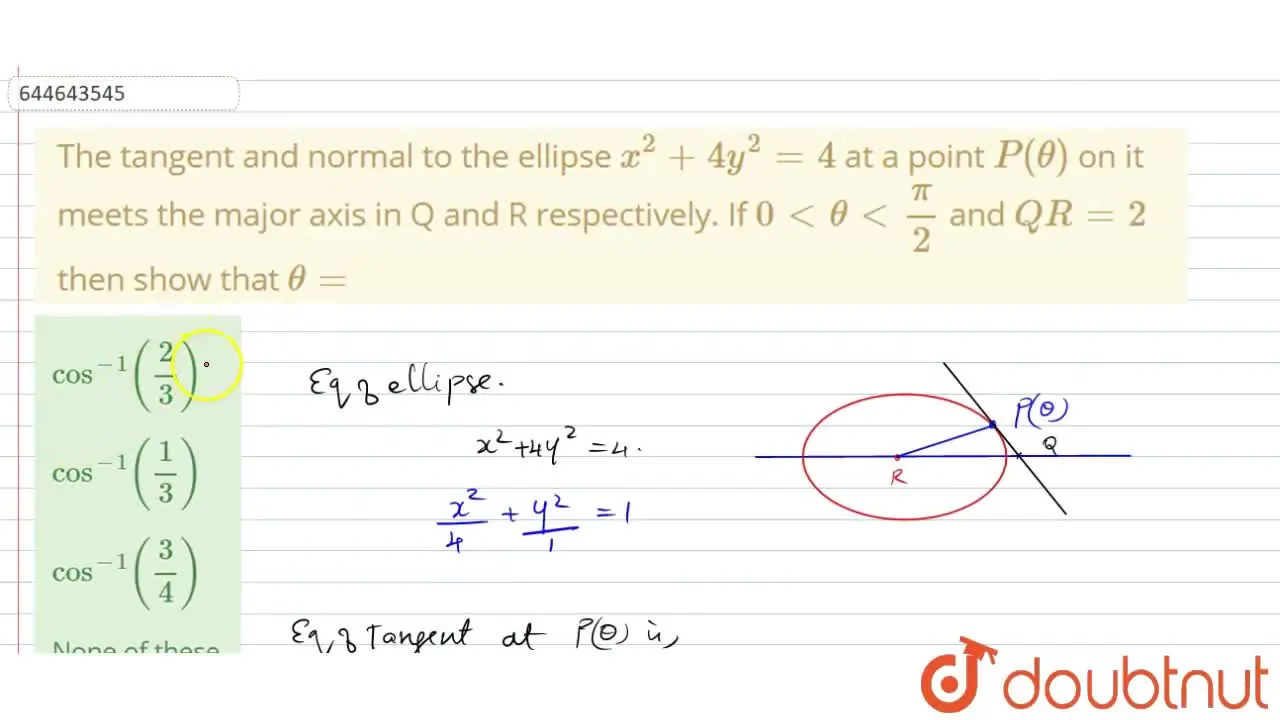The tangent and normal to the ellipse x2+4y2=4 at a point P(θ) on it meets the major axis in Q and R respectively. If 0<θ<π2 and QR=2 then show that θ=
cos−1(23)
cos−1(13)
cos−1(34)
None of these
The correct Answer is:A
Step by step video & image solution for The tangent and normal to the ellipse x^2+4y^2=4 at a point P(theta) on it meets the major axis in Q and R respectively. If 0 < theta < pi/2 and QR=2 then show that theta= by Maths experts to help you in doubts & scoring excellent marks in Class 12 exams.
Related Playlists
- BOOK - VMC MODULES ENGLISHCHAPTER - CONIC SECTIONSEXERCISE - Numerical Value Type for JEE Main15videos
CONIC SECTIONS
- BOOK - VMC MODULES ENGLISHCHAPTER - CONIC SECTIONSEXERCISE - JEE MAIN ARCHIVE15videos
CONIC SECTIONS
- BOOK - VMC MODULES ENGLISHCHAPTER - CONIC SECTIONSEXERCISE - LEVEL - 1178videos
CONIC SECTIONS
- BOOK - VMC MODULES ENGLISHCHAPTER - COMPLEX NUMBERS EXERCISE - JEE ARCHIVE76videos
COMPLEX NUMBERS
- BOOK - VMC MODULES ENGLISHCHAPTER - DIFFERENTIAL CALCULUSEXERCISE - JEE Advanced (Archive)75videos
DIFFERENTIAL CALCULUS
Similar Questions
The tangent and normal to the ellipse x2+4y2=4 at a point P(0) on it meets the major axis in Q and R respectively. If 0<π2 and QR = 2 then show that θ=cos−1(23) .
View SolutionIf the tangent and normal to the ellipse x2+4y2=4 at point P(θ) meets the major axes in QandR respectively, and QR=3, then (A) cosθ=1√3 (B) cosθ=13 (C) cosθ=23 (D) cosθ=(−23
View SolutionThe tangent PT and the normal PN to the parabola y2=4ax at a point P on it meet its axis at points T and N, respectively. The locus of the centroid of the triangle PTN is a parabola whose:
View SolutionTangent PT and normal PN to the parabola y2=4ax at a point P on it meet its axis at T and N respectively. The Locus of the centroid of the triangle PTN is a parabola whose
View SolutionThe tangent and normal at any point P of an ellipse x2a2+y2b2=1 cut its major axis in point Q and R respectively. If QR=a prove that the eccentric angle of the point P is given by e2cos2ϕ+cosϕ−1=0
View SolutionThe tangent and normal at the point P(4,4) to the parabola, y2=4x intersect the x-axis at the points Q and R, respectively. Then the circumcentre of the ΔPQR is (a) (2,0) (b) (2,1) (c) (1,0) (d) (1,2)
View SolutionIf a tangent to the ellipse x2a2+y2b2=1, whose centre is C, meets the major and the minor axes at P and Q respectively then a2CP2+b2CQ2 is equal to
View SolutionIf the normal to the rectangular hyperbola x2−y2=4 at a point P meets the coordinates axes in Q and R and O is the centre of the hyperbola , then
View SolutionTangent and normal at any point P of the parabola y2=4ax(a>0) meet the x-axis at T and N respectively. If the lengths of sub-tangent and sub-normal at this point are equal, then the area of ΔPTN is given by
View SolutionIf the tangent to the ellipse x2+2y2=1 at point P(1√2,12) meets the auxiliary circle at point RandQ , then find the points of intersection of tangents to the circle at QandR.
View Solution


